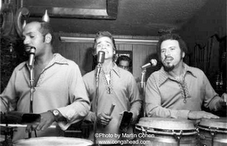

Latin entertainment has always found a comfortable climate in
New York. Carmen Miranda’s samba, Valentino’s tango, José Greco’s and La Argentinita’s flamenco, Lecuona’s piano and the romantic boleros of
Mexico’s Tito Guizar,
Cuba’s
Arsenio and
Puerto Rico’s
Rafael Hernandez found a home here.
Although Latin talent remained unaffected, a change occurred in the nightclubs. The business began to distance itself from its “Spanish” identity. This was due to the fascists’ Spanish Civil War victory—a factor that caused club owners to avoid the correlation by adopting French names for venues featuring the hottest Cuban and Puerto Rican orchestra. The matchbook advertisements for the Havana-Madrid club shows only the Moro Castle and conceals the “Madrid” image. The owners, the Lopez brothers, opened a second club called Chateau Madrid at 42 W. 58th Street, just two blocks from the swanky Copacabana, when it was located at 10 E. 60th Street, in a less liberal-minded neighborhood. This matchbook showed only a French-style chateau. They obviously were aware of the political variance of the times. By their new location, they now could continue to enjoy the “Spanish” Madrid aspect, as well as their liberal West side Broadway image.
The very popular La Conga was forced to change its name to China Doll due not to the Spanish Civil War outcome, but rather due to competition from Chin Lee’s. With Machito y sus Afro-Cubanos, it still called itself “New York’s only Chinese nightclub.” This in spite of its tropical palm tree décor and shows.
El Libario left the upscale area of W. 57th Street in order to open at 884 Eight Avenue, a more liberal-minded area. The décor of El Libario changed from a very elegant raffinée display to one of jibaros and sugar cane fields, and featured the very young Celia Cruz. This move was not so much due to fickle political sensitivity as it was to better situate its accessibility to the rumba crowd.
Continuing the trend towards contrived French-titled clubs in the 1940s was the elegant Versailles at 151 E. 50th Street, where upper-crust café society enjoyed the best Latin Saturday rumba matinees. At FeFe’s Monte Carlo, 49 E. 54th Street, you found excellent rumba. “Styled and designed by Dorothy Draper,” Hollywood’s interior decorator. This interest in novel décor was inspired by the flashy zebra-striped walls of Club El Morocco. As part of an artistic awakening after World War II, it caught the attention and imagination of the club-going public, as well as the general public.
Two other Latin clubs with French inclinations were the popular La Martinique at 57 W. 57th Street, featuring José Curbelo, and the Embassy, also on 57th Street, but east, featuring Fausto Curbelo. La Martinique, owned by Ramon and Dario, two brothers, captured the rumba crowd by turning its air conditioning up more than its rivals at a time when air conditioning was just arriving on the scene in congested dance clubs.
The Latin Quarter, upstairs at 200 W. 48th Street, had the largest dance floor and the largest Latin bands. It called itself “America’s Smartest Night Club,” with branches at Palm Island Casino, Miami Beach, and Boston. Today, you can find it presenting great bands on Madison Avenue, where you might run into Larry Harlow.
While top rumba bands played for shows that at times featured average Apache dancers from France at Gaston Edourd’s Monte Carlo, the club scene became ever more a mixed bouillabaisse. In spite of its West Houston Street location, S.O.B.’s proved that it’s not always “location, location, location.” The music is the draw. Originally Brazilian, S.O.B.’s offers West African, Haitian drums, Portugese fado, a cappella, jazz and great salsa among other attractions. The kitchen is challenged nightly to prepare menus for a variety of palate demands. With a prime location on the corner of the Empire State Building at Fifth Avenue and 34th Street., the Riverboat, with excellent salsa, couldn’t survive with an after-work crowd, since at 11pm, the building closed for the night, discouraging attendance. Son Cubano, on W. 14th Street, comes alive in the late-hour meat market locale, with Marin’s Latin band. The Corso, with another excellent location on E. 86th Street, upstairs, could not survive its sordid suspicious activities. (The location of the 1940s Yumuri, with authentic Cuban sounds, was in a bad area that even great music couldn’t hide.)
A split-level club called One If By Land, Two If By Sea, situated in a coach house once owned by Aaron Burr at 17 Barrow Street, was once a restaurant called 17. In 1939, when it was the Café Latino, I shot dice in the basement with José Mangual, Sr., and the conjunto members. The very exotic Middle Eastern, early 1970s stylish Ibis Supper Club, 59 E. 54th Street, had top Latin bands. On top of the World Trade Center, a rumba band played nightly at Windows on the World. The music from Africa Lejana had reached, in a way, its zenith.
The lowly throwaway matchbook, which is disappearing with less smoking, preserved the history of some long-gone dance clubs. At a time when a room with bath in the heart of Times Square at the new Astor Hotel charged $3 a night, there was a Latin club called Gold Coast at 249 Sullivan Street. It was advertised as being “around the corner from 50 Washington Square South. ¾ lb. Delmonico steak: 65¢; Spaghetti: 35¢.” It was there on the dance floor during a slow rumba that my father proposed to my mother. That’s the night I was born…to dance.










